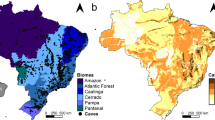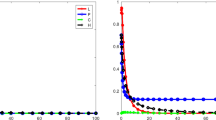Summary
-
(1)
Wars between colonies of the red wood ant, Formica polyctena (Foerst.), are very common in the study area, a dune valley near The Hague, The Netherlands. In an extensive study Mabelis (1979) has put forward a hypothesis that explains the occurrence of wars in terms of protein supply in periods of insufficient prey availability. As prey density is low in early spring, most wars occur in this period. While Mabelis' evidence was mainly experimental, this field study was carried out to evaluate his hypothesis by permanent simultaneous measurements of prey/ protein intake of a colony, availability of prey in the foraging area and the protein demand.
-
(2)
The participation of the study colony in wars with three of its neighbours is described.
-
(3)
Conspecific war casualties, Bibionidae and Lepidoptera larvae amounted to 86.3% of the total prey intake during the first 80 days of the season of 1980.
-
(4)
There was an obvious, sudden switch around 6 May from conspecific to other prey.
-
(5)
Before this switch no Bibionidae or Lepidoptera larvae could be detected in the field.
-
(6)
Also prey species other than Bibionidae and Lepidoptera larvae are, for different reasons, not regarded as a significant food resource during the period of wars.
-
(7)
During spring battles there was a fluctuating but relatively high protein demand.
-
(8)
These results support Mabelis' hypothesis.
-
(9)
Proximate causes of cannibalism, other hypotheses on wood ant wars and the role of cannibalism in the regulation of wood ant and prey populations are discussed.
Similar content being viewed by others
References
Auclair JL (1963) Aphid feeding and nutrition. Ann Rev Ent 8:439–490
Banks CL, Macaulay EDM (1965) The ingestion of nitrogen and solid matter from Vicia faba by Aphis fabae Scop. Ann appl Biol 55:207–218
Betrem JG (1960) Über die Systematik der Formica rufa Gruppe. Tijdschr Entom 103:51–81
Bruyn GJ de (1978) Food territories in Formica polyctena Foerst. Neth J Zool 28 (1):55–61
Bruyn GJ de, Kruk-de Bruin M (1972) The diurnal rhythm in a population of Formica polyctena Foerst. Ekol Polska 20:117–127
Bruyn GJ de, Mabelis AA (1972) Predation and aggression as possible regulatory mechanisms in Formica. Ekol Polska 20:93–101
Cherix D (1978) Regulation et agressivité chez Formica lugubris Zett. dans le Jura (Hymenoptera, Formicidae). Proc VIII Int Symp Pol Ent Soc section Soc Ins, Pulawy, pp 7–12
Elton ETG (1958) The artificial establishment of wood ant colonies for biological control in The Netherlands. Proc X Int Congr Ent 4:573–594
Finnegan RJ (1975) Introduction of predacious red wood ant, Formica lugubris (Hymenoptera: Formicidae) from Italy to eastern Canada. Can Entom 107:1271–1274
Gösswald K (1979) Auswirkungen der Waldameisen im Eichenwald. Waldhygiene 13(1):3–10
Lange R (1962) Phasen wechselnder Jagdintensität bei Waldameisen. Z angew Ent 50:56–64
Mabelis AA (1979) Wood ant wars. The relationship between aggression and predation in the red wood ant (Formica polyctena Först.). Neth J Zool 29 (4):451–620
Nell HW (1972) Over de relatie tussen eiwitaanvoer en reproductie bij een nest van de rode bosmier, Formica polyctena Först. Unpublished thesis, Department of Population Biology, Division of Ecology, University of Leiden, The Netherlands
Otto P (1962) Die rote Waldameise. Die neure Brehm Bücherei, Ziemsen Verlag, Wittenberg
Rosengren R (1977) Foraging strategy of wood ants (Formica rufa group). I. Age polyethism and topographic traditions. Acta Zool Fenn 149:1–30
Skinner GJ (1980) The feeding habits of the wood ant Formica rufa (Hymenoptera: Formicidae), in limestone woodland in North-West England. J Anim Ecol 49:417–433
Stitz H (1939) Die Tierwelt Deutschlands (Hymenoptera, 1. Formicidae). Fischer Verlag, Jena
Vos P (1980) De veranderingen gedurende het seizoen in de mate van informatieoverdracht bij de rode bosmier, Formica polyctena Foerst. Unpublished thesis, Department of Population Biology, Division of Ecology, University of Leiden, The Netherlands
Way MJ (1963) Mutualism between ants and honeydew producing Homoptera. Ann Rev Ent 8:307–344
Author information
Authors and Affiliations
Additional information
Publication of the ‘Meijendel-comité’, new series, no. 69
Rights and permissions
About this article
Cite this article
Driessen, G.J.J., Van Raalte, A.T. & De Bruyn, G.J. Cannibalism in the red wood ant, Formica polyctena (Hymenoptera: formicidae). Oecologia 63, 13–22 (1984). https://doi.org/10.1007/BF00379779
Received:
Issue Date:
DOI: https://doi.org/10.1007/BF00379779




